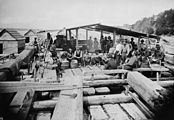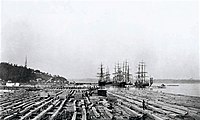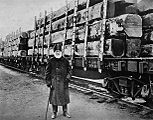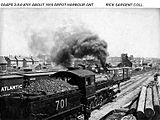John Rudolphus Booth
John Rudolphus Booth | |
|---|---|
Ottawa, Ontario, Canada | |
| Resting place | Beechwood Cemetery, Ottawa |
| Spouse | Rosalinda Cook |
John Rudolphus Booth (April 5, 1827 – December 8, 1925) was a Canadian
He arrived in Bytown (later renamed Ottawa) at the same time as many other future lumber entrepreneurs such as Henry Bronson, W.G. Perley, John Harris[a] and E.B. Eddy. Even so, by 1890 Booth had overtaken them all to become the largest lumber producer in the world.[2] It was said that at one point the timberlands under his control occupied an area larger than France.[2]
He was familiar with all aspects of his industry, and one observer noted:
[He] knew the forest as a sailor knows the sea, and his success was largely due to the fact that he never overestimated its potentialities.[1]
Early life
J. R. Booth was born on a farm at Lowes near Waterloo (Shefford County) in the Eastern Townships of Quebec. His parents, John and Eleanor Booth (née Rowley) were Irish immigrants, had a number of children (variously reported as 5, 6 and 8); his paternal grandparents were John Booth and Elizabeth Hill; his patrilineal grandfather, Robert Booth who married Eleanor Taylor, was the son of Peter Booth,[3] whose father, James Booth, a Freeman of Dublin, was 4th son of the Revd Humphrey Booth and Letitia Jones.[4]
John Booth left the family farm at the age of 21 and got a job as a
Building a lumber and railway empire
-
Boothlumber camp, Aylen Lake, Ontario, c. 1895
-
Cookery on Booth timber raft
-
J.R. Booth in front of Canada Atlantic Railway timber train
-
Booth's lumber piling ground
Lumber
Booth harvested timber from the upper Ottawa River and its tributaries,
Booth's vision and boldness were qualities that made him a success. In 1867, he purchased, for $40,000,
During the latter half of the 19th Century, he amassed timber rights approaching 7,000 square miles (18,000 km2) in Central and Northern Ontario which he would harvest for his mills.[7] He often went to his Algonquin timber limits in his own private railway car, working beside his men during the day and on business affairs most of the night, seldom sleeping for more than a few hours.[7] He was always on the lookout for opportunities to reduce costs, and in 1894 he began investing in tugboats in order to accelerate the delivery of log booms to the Chaudière mill.[12]
In 1891, Booth installed 13
Half of the mills' output was shipped to England; the rest to the United States and throughout Canada.
The mills' output was so large that its Fraserfield
The Chaudière Island mills were so extensive that Booth issued tokens for use there, which were in circulation from 1893 until the 1940s.[19]
Fire was a constant threat to his mills, and they burnt down in 1893, 1886, 1900 and 1903. In 1900 alone, 100 million feet of lumber was lost to fire, and Booth also lost his home located at Wellington and Preston Street.[20] The extent of the fire led to a controversial proposal to restrict the amount of lumber being held in the yards, but intensive lobbying by Booth and other lumbermen effectively killed that measure as well as a later one in 1903.[21] Much of Booth's personal and business records were lost in these fires. It was also of concern within the timber limits as well, and Booth once said, "If fires are kept out of the forests, there will be more pine in this country 100 years from now than there was fifty years ago, and we shall have lots of timber for the generation to come."[22]
Booth established a hydroelectric
Railways
| Canada Atlantic Railway and predecessors | |||||||||||||||||||||||||||||||||||||||||||||||||||||||||||||||||||||||||||||||||||||||||||||||||||||||||||||||||||||||||||||||||||||||||||||||||||||||||||||||||||||||||||||||||||||||||||||||||||||||||||||||||||||||||||||||||||||||||||||||||||||||||||||||||||||||||
|---|---|---|---|---|---|---|---|---|---|---|---|---|---|---|---|---|---|---|---|---|---|---|---|---|---|---|---|---|---|---|---|---|---|---|---|---|---|---|---|---|---|---|---|---|---|---|---|---|---|---|---|---|---|---|---|---|---|---|---|---|---|---|---|---|---|---|---|---|---|---|---|---|---|---|---|---|---|---|---|---|---|---|---|---|---|---|---|---|---|---|---|---|---|---|---|---|---|---|---|---|---|---|---|---|---|---|---|---|---|---|---|---|---|---|---|---|---|---|---|---|---|---|---|---|---|---|---|---|---|---|---|---|---|---|---|---|---|---|---|---|---|---|---|---|---|---|---|---|---|---|---|---|---|---|---|---|---|---|---|---|---|---|---|---|---|---|---|---|---|---|---|---|---|---|---|---|---|---|---|---|---|---|---|---|---|---|---|---|---|---|---|---|---|---|---|---|---|---|---|---|---|---|---|---|---|---|---|---|---|---|---|---|---|---|---|---|---|---|---|---|---|---|---|---|---|---|---|---|---|---|---|---|---|---|---|---|---|---|---|---|---|---|---|---|---|---|---|---|---|---|---|---|---|---|---|---|---|---|---|---|---|---|---|---|---|
| |||||||||||||||||||||||||||||||||||||||||||||||||||||||||||||||||||||||||||||||||||||||||||||||||||||||||||||||||||||||||||||||||||||||||||||||||||||||||||||||||||||||||||||||||||||||||||||||||||||||||||||||||||||||||||||||||||||||||||||||||||||||||||||||||||||||||
Formation of Canada Atlantic
Booth's sawmill operations could never run at full capacity because the output could not be carried out of the lumber yards fast enough.
Canada Atlantic - OA&PS | ||||||||||||||||||||||||||||||||||||||||||||||||||||||||||||||||||||||||||||||||||||||||||||||||||||||||||||||||||||||||||||||||||||||||||||||||||||||||||||||||||||||||||||||||||||||||||||||||||||||||||||||||||||||||||||||||||||||||||||||||||||||||||||||||||||||||||||||||||||||||||||||||||||||||||||||||||||||||||||||||||||||||||||||||||||||||||||||||||||||||||||||||||||||||||||||||||||||||||||||||||||||||||||||||||||
|---|---|---|---|---|---|---|---|---|---|---|---|---|---|---|---|---|---|---|---|---|---|---|---|---|---|---|---|---|---|---|---|---|---|---|---|---|---|---|---|---|---|---|---|---|---|---|---|---|---|---|---|---|---|---|---|---|---|---|---|---|---|---|---|---|---|---|---|---|---|---|---|---|---|---|---|---|---|---|---|---|---|---|---|---|---|---|---|---|---|---|---|---|---|---|---|---|---|---|---|---|---|---|---|---|---|---|---|---|---|---|---|---|---|---|---|---|---|---|---|---|---|---|---|---|---|---|---|---|---|---|---|---|---|---|---|---|---|---|---|---|---|---|---|---|---|---|---|---|---|---|---|---|---|---|---|---|---|---|---|---|---|---|---|---|---|---|---|---|---|---|---|---|---|---|---|---|---|---|---|---|---|---|---|---|---|---|---|---|---|---|---|---|---|---|---|---|---|---|---|---|---|---|---|---|---|---|---|---|---|---|---|---|---|---|---|---|---|---|---|---|---|---|---|---|---|---|---|---|---|---|---|---|---|---|---|---|---|---|---|---|---|---|---|---|---|---|---|---|---|---|---|---|---|---|---|---|---|---|---|---|---|---|---|---|---|---|---|---|---|---|---|---|---|---|---|---|---|---|---|---|---|---|---|---|---|---|---|---|---|---|---|---|---|---|---|---|---|---|---|---|---|---|---|---|---|---|---|---|---|---|---|---|---|---|---|---|---|---|---|---|---|---|---|---|---|---|---|---|---|---|---|---|---|---|---|---|---|---|---|---|---|---|---|---|---|---|---|---|---|---|---|---|---|---|---|---|---|---|---|---|---|---|---|---|---|---|---|---|---|---|---|---|---|---|---|---|---|---|---|---|---|---|---|---|---|---|---|---|---|---|---|---|---|---|---|---|---|---|---|---|---|---|---|---|---|---|---|---|---|---|---|---|---|---|---|---|---|---|---|---|
| ||||||||||||||||||||||||||||||||||||||||||||||||||||||||||||||||||||||||||||||||||||||||||||||||||||||||||||||||||||||||||||||||||||||||||||||||||||||||||||||||||||||||||||||||||||||||||||||||||||||||||||||||||||||||||||||||||||||||||||||||||||||||||||||||||||||||||||||||||||||||||||||||||||||||||||||||||||||||||||||||||||||||||||||||||||||||||||||||||||||||||||||||||||||||||||||||||||||||||||||||||||||||||||||||||||
Canada Atlantic - Ottawa to Vermont | |||||||||||||||||||||||||||||||||||||||||||||||||||||||||||||||||||||||||||||||||||||||||||||||||||||||||||||||||||||||||||||||||||||||||||||||||||||||||||||||||||||||||||||||||||||||||||||||||||||||||||||||||||||||||||||||||||||||||||||||||||||||||||||||||||||||||||||||||||||||||||||||
|---|---|---|---|---|---|---|---|---|---|---|---|---|---|---|---|---|---|---|---|---|---|---|---|---|---|---|---|---|---|---|---|---|---|---|---|---|---|---|---|---|---|---|---|---|---|---|---|---|---|---|---|---|---|---|---|---|---|---|---|---|---|---|---|---|---|---|---|---|---|---|---|---|---|---|---|---|---|---|---|---|---|---|---|---|---|---|---|---|---|---|---|---|---|---|---|---|---|---|---|---|---|---|---|---|---|---|---|---|---|---|---|---|---|---|---|---|---|---|---|---|---|---|---|---|---|---|---|---|---|---|---|---|---|---|---|---|---|---|---|---|---|---|---|---|---|---|---|---|---|---|---|---|---|---|---|---|---|---|---|---|---|---|---|---|---|---|---|---|---|---|---|---|---|---|---|---|---|---|---|---|---|---|---|---|---|---|---|---|---|---|---|---|---|---|---|---|---|---|---|---|---|---|---|---|---|---|---|---|---|---|---|---|---|---|---|---|---|---|---|---|---|---|---|---|---|---|---|---|---|---|---|---|---|---|---|---|---|---|---|---|---|---|---|---|---|---|---|---|---|---|---|---|---|---|---|---|---|---|---|---|---|---|---|---|---|---|---|---|---|---|---|---|---|---|---|---|---|---|---|---|---|---|---|---|---|---|---|
| |||||||||||||||||||||||||||||||||||||||||||||||||||||||||||||||||||||||||||||||||||||||||||||||||||||||||||||||||||||||||||||||||||||||||||||||||||||||||||||||||||||||||||||||||||||||||||||||||||||||||||||||||||||||||||||||||||||||||||||||||||||||||||||||||||||||||||||||||||||||||||||||
| (* - miles from Depot Harbour) | |||||||||||||||||||||||||||||||||||||||||||||||||||||||||||||||||||||||||||||||||||||||||||||||||||||||||||||||||||||||||||||||||||||||||||||||||||||||||||||||||||||||||||||||||||||||||||||||||||||||||||||||||||||||||||||||||||||||||||||||||||||||||||||||||||||||||||||||||||||||||||||||
Expansion to Georgian Bay


In 1888, Booth chartered the Ottawa, Arnprior and Renfrew Railway to build a line from Ottawa to
When the PSCR was taken over by Booth, the original intention was to have its terminus at
All three lines met "end to end". The M&OJ met the OA&PS on Booth's sawmill property in Ottawa while the C&PL met the M&OJ in Coteau, using several hundred feet of trackage rights of the Grand Trunk Railway (GTR). In 1899, the OA&PS amalgamated with the CAR.[32][33] As a result, Booth ruled the largest railway empire built in North America by any one man.
It was said that the first phase of the CAR's construction was undertaken without any government assistance, which was unusual at the time.[34] Booth himself was concerned with building the railways as well as marketing the service to build and maintain tonnage on the new lines.[35] He was open to cooperation with other railways in eastern and western Canada, as well as to sale or amalgamation with a larger railway system, and was contemplating such a sale by 1901.[36] Whether it was because Booth at age 74 was tired, or because he realized that competition from other transcontinental lines would soon cause serious problems for the CAR, he did everything possible in the early years of the 20th century to make every aspect of the railway profitable, and therefore attractive to potential buyers.[37]
Booth also operated grain elevators at Depot Harbour, Coteau, Duluth and Milwaukee, and steamships on the Great Lakes, and formed the Canada Atlantic Transit Company, which operated five large lake freighters on the Upper Great Lakes.
-
Depot Harbour elevators in 1910
-
OA&PS engine #701 2-8-0 built by Baldwin Locomotive Works. The engine is shown in Depot Harbour, the western end of the line.
Sale to Grand Trunk
Prompted by the federal government, the
Other interests

At the creation of the Lady Stanley Institute for Trained Nurses in 1890 in Ottawa, he was a member of the Provisional Committee. Later in 1892, he became Life Governor of that same Institute by paying at least the amount of $500.[41]
Booth was a significant investor in the Canada Cement Company formed by
Together with
Later years
J. R. Booth continued to run his business empire well into his nineties. Only in 1921 did he convert it from a sole proprietorship into a corporation (known as J.R. Booth Limited).[51] He died in 1925 at the age of 98 after being ill for several months and was survived by his sons Jackson, John Frederick, daughter Helen Gertrude Fleck and several grandchildren and great grandchildren.
In 1943, J.R. Booth Limited, with the exception of its lumber division, was sold to George Weston Limited to become part of the E. B. Eddy Company.[52] The lumber mill was later sold to E. B. Eddy in 1946.
Other influences

Booth's impact was significant on Ottawa:
- The right of way used by the Ottawa, Arnprior and Parry Sound Railway within Ottawa is now used as the Queensway.
- Booth Street in Ottawa (which connects to Gatineau, Quebec and chemin Booth in Kingsmere, Quebec, were named in his honour.[53]
- J.R. Booth leased a property on Lac Deschênes to the Britannia Bay Boating Club. Designed by Edgar Lewis Horwood, the clubhouse was opened in 1896.
- J.R. Booth donated the land on the southwest corner of Richmond Road and Britannia Road for the Britannia Heights Methodist Church, which had been meeting in homes since 1869. The Britannia Heights Methodist Church formed in 1873.[54]
- The acreage he acquired for pasturing the horses for his mills would later become the Dominion Experimental Farm.
- Booth also had a summer home in Kingsmere, Quebec, on the north shore of Kingsmere Lake.[55]
In Algonquin Provincial Park, Booth Lake[56] is named after him. However, most other traces of Booth's interests in the Park (including a summer retreat at the Barclay Estate[57][58] on Rock Lake)[59] were razed by the Province of Ontario[60] as their leases on crown land ran out.[61]
Two
In 1892, Booth rented a cottage at
One of Booth's descendants noted in 2016 that the manner in which his predecessor had gathered his wealth was exceptional in comparison to "really old-school wealthy families" in Canada, "as most of them came from the booze business, which was illegal. So they didn’t pay taxes; it was all cash. So what J.R. did was that much more impressive."[53]
Death, descendants and legacy
Booth died in December 1925. On his passing,
not the great magnate whose wealth is the envy of many and the wonder of more; but the great pioneer, the man whose genius and imagination tamed the wilderness . . . and, above all, did more than any man of his time to build up this Ottawa Valley.
Also at that time, William Lyon Mackenzie King observed:
Mr. Booth was indeed one of the Fathers of Canada; it is not too much to say that it is to men of such sterling worth and indomitable will as he possessed, more than aught else, that we owe the development of our Dominion.[67]
Booth's fortune was a subject of much speculative commentary during the latter years of his life, with estimates ranging up to $100 million. At his death his estate was officially valued at almost $7.7 million; the property was later re-evaluated upwards to $23 million.[68] Although succession duties of $4.28 million were paid in 1927,[69] in 1937 Ontario Premier Mitchell Hepburn subsequently claimed more and had the Legislative Assembly of Ontario pass the necessary legislation to overcome the legal obstacles.[70] J.R's heirs eventually paid another $3 million in 1939.[71]
His son John Frederick Booth, who lived in Canada, married and had a daughter Lois Frances Booth (born Ottawa, Ontario, 2 August 1897; died Copenhagen, 26 February 1941), who was married in Ottawa, Ontario, on 11 February 1924 to
Siblings and descendants


- John Booth (1802–1877), m. (1st) Eleanor Rowley (1804–1834) (2nd) Lydia Bickford (1808–1861) (3rd) Suzannah Bickford (1814–1888)
- James Rowley Booth (1825–1906)
- John Rudolphus Booth (1827–1925), m. Rosalinda Cooke (1829–1886)
- Frances Gertrude Booth (1854–1856)
- Helen Gertrude Booth (~1855–1940), m. Andrew Walker Fleck (1848–1924)
- Lila Booth (1858–1918), m. J. Arthur Seybold (1859–1928)
- Augusta Adella Booth (1860–1866)
- Charles Jackson Booth (1863–1947),[73][74] m. Jessie Louise Gibson (1876–1939)
- John Frederick Booth (1865–1930), m. Frances Alberta Hunsiker (1866–1964)
- John Rudolphus Booth (1895–1941),[77] m. (1st) Ida Evelyn Woods (1900–) (2nd) Elizabeth Jane Smith (1909–)
- Frederick Hunsiker Booth (1895–1941),[80] m. (1st) Louise Taylor (1898–)[81] (2nd) Cornelia Ann Vanderhoef (1911–1995)
- Elizabeth Ann Booth[82] (1934-)
- Lois Frances Booth (1897–1941), m. (1st) Count Erik of Rosenborg(1890–1950) (2nd) Gunnar Thorkil Juelsberg (1904–1966)
- Alexandra Dagmar Frances Marie Margrethe, Countess of Rosenborg (1927–1992)
- Christian Edward Valdemar Jean Frederik Peter, Count of Rosenborg (1932–1997)
- Frank Booth (1867–1869)
- May Belle Booth (1876–1899)
- William Booth (1829–1913)
- Eliza Booth (1831)
- Robert Rowley Booth (1832–1899)
- Louis Elijah Booth (1835–1915)
- Eleanor Booth (1839–1842)
- Charlotte Booth (1841–1912)
- Lucinda Booth (1842–1933)
- Samuel Armstrong Booth (1844–1920)
- Isaiah (Isaac) Booth (1845–1928)
- Edward J. Booth (1846–1849)
- Edward Judson Booth (1852–1943)
See also
Notes and references
Notes
- ^ Bronson's partner
References
- ^ a b c d Benidickson 2005.
- ^ a b Deachman, Bruce (July 17, 2017). "The Capital Builders: J.R. Booth, 'monarch of the Upper Ottawa'". Ottawa Citizen.
- ^ "www.darvercastle.ie". Archived from the original on 2018-11-12. Retrieved 2019-03-11.
- ^ Burke's Peerage, Burke's Peerage & Baronetage, qv. BOOTH, Bt
- ^ Bell 1991, p. 3
- ^ a b "Biography – BOOTH, JOHN RUDOLPHUS – Volume XV (1921-1930) – Dictionary of Canadian Biography".
- ^ a b c Bell 1991, p. 5.
- ^ a b c d Brown 1994, p. 191.
- ^ ISBN 978-1-4251-5342-7.
- ^ Westhouse, Brian. "History of Logging and Lumber Railways in Ontario". Retrieved 2010-05-12.
- ^ An Act to incorporate the Nosbonsing and Nipissing Railway Company, S.O. 1886, c. 74
- ^ a b c Barrett & Coons 2010, p. 97.
- ^ Lee 2006, p. 128.
- ^ Lee 2006, p. 211.
- ^ a b Bell 1991, p. 8.
- ^ Lee 2006, p. 61.
- ^ John Leaning. "The Story of The Glebe". Glebe Historical Society. Archived from the original on 2012-09-12. Retrieved 2014-12-07.
- ^ Bruce Scrivens (October 1, 2004). "Life in the J.R. Booth Lumber Yard". Scrivens.
- ^ P.S. Berry. "Trade and Other Tokens of the Gatineau Region" (PDF). Bank of Canada Museum. p. 9.
- ISSN 1918-5138., at pp. 41-43
- ^ Fear 1979, pp. 56–65.
- ^ Nelles 2005, p. 195.
- ^ Lee 2006, p. 129.
- ^ Lee 2006, p. 88.
- ^ An Act to amend the Acts incorporating the 'Coteau and Province Line Railway and Bridge Company' and the 'Montreal and City of Ottawa Junction Railway Company,' and amending Acts, and to amalgamate the said Companies, S.C. 1879, c. 57
- ^ Bell 1991, pp. 38–40
- ^ An Act to incorporate the Ottawa, Arnprior and Renfrew Railway Company, S.O. 1888, c. 71
- ^ An Act to incorporate the Ottawa and Parry Sound Railway Company, S.C. 1888, c. 65
- ISBN 1-896219-91-8.
- ^ An Act to amend the Act to incorporate the Ottawa, Arnprior and Renfrew Railway Company, S.O. 1891, c. 91 , An Act to amend the Act to incorporate the Parry Sound Colonization Railway Company, S.O. 1891, c. 92 and An Act amalgamating the Ottawa and Parry Sound Railway Company, and the Ottawa, Arnprior and Renfrew Railway Company, under the name of 'The Ottawa, Arnprior and Parry Sound Railway Company', S.C. 1891, c. 93
- ^ a b c Brown 1994, p. 201.
- ^ An Act to amalgamate the Ottawa, Arnprior and Parry Sound Railway Company and the Canada Atlantic Railway Company under the name of the Canada Atlantic Railway Company, S.C. 1899, c. 81
- ^ Bell 1991, p. 158
- ^ Lee 2006, p. 103.
- ^ Bell 1991, p. 137
- ^ Bell 1991, p. 139
- ^ Bell 1991, p. 142
- ^ Bell 1991, pp. 143–144
- ^ The Grand Trunk and Canada Atlantic Amalgamation Act, 1914, S.C. 1914, c. 89
- ^ Bell 1991, p. 160
- ^ The Lady Stanley Institute for Trained Nurses, incorporated 1890. Ottawa: Free Press Office, Cor. Queen and Elgin Street, 1892. Scanned reproduction of original artifacts. Scholar Select.
- ^ "About Lafarge North America - History". Lafarge North America. Retrieved March 14, 2013.
- ^ Davis, Harold Palmer (1910). "Cobalt, 1903". The Davis Handbook of The Cobalt Silver District. Toronto: Canadian Mining Journal. pp. 8–9.
- ^ Nelles 2005, p. 329.
- ^ Martin 2005, pp. 7–8.
- ^ The British America Nickel Corporation Limited and others v M. J. O'Brien Limited [1927] UKPC 7, [1927] AC 369 (18 January 1927), P.C. (on appeal from Ontario)
- ^ Craig Barrett (November 7, 2012). "English courts uphold rights of minority bondholders". Chadbourne & Parke LLP.
- ^ Saugata Mukherjee; James Yao (October 2013). "Look Beyond the Contract: Restructuring Infrastructure Debt" (PDF). Stephenson Harwood LLP. Archived from the original (PDF) on 2015-04-12.
- ^ "Inco Limited". Reference for Business.
- ^ Martin 2005, p. 10.
- ^ "J.R. Booth, Limited, incorporated". Pulp and Paper Magazine of Canada. Vol. XIX, no. 4. 27 January 1921. p. 98.
- Montreal Gazette. August 12, 1943. Retrieved March 14, 2013.
- ^ a b c Deachman, Bruce (February 19, 2016). "The Booths: A famous name (and nose) mostly a blessing, sometimes a curse". Ottawa Citizen.
- ^ Ottawa Journal "Britannia United Church" 2 October 1976
- ^ "John Rudulphous Booth summer home". waymarking.com. Retrieved March 14, 2013.
- ^ 45°39′27″N 78°11′15″W / 45.6574999°N 78.1874999°W
- ^ Brown 1994, p. 196.
- ^ "Barclay Estate - Rock Lake". Ontario Abandoned Places.
- ^ 45°31′34″N 78°24′36″W / 45.526070°N 78.409959°W
- ^ Brown 1994, p. 192.
- ^ Brown 1994, p. 197.
- ^ 46°45′N 78°40′W / 46.750°N 78.667°W
- Ministère des Ressources naturelles, Faune et Parcs. 2004. p. 5. Archived from the original(PDF) on 2016-04-02. Retrieved 2017-01-22.
- ^ 49°5′42″N 88°21′0″W / 49.09500°N 88.35000°W
- ^ "Booth". rncan.gc.ca. Geographical Names Board of Canada. 2016.
- ^ "John R. Booth". Historic Saranac Lake. Archived from the original on April 16, 2013. Retrieved March 14, 2013.
- ^ "Booth's Funeral". Trinity Western University. Archived from the original on September 21, 2013. Retrieved August 20, 2013.
- ^ Doug Mackey (October 27, 2000). "A closer look at lumber baron J.R. Booth". Community Voices.
- ^ "Claims Booth Duties Paid". Regina Leader-Post. September 18, 1937. Retrieved September 24, 2013.
- Montreal Gazette. December 3, 1937. Retrieved September 24, 2013.
- ^ "Ottawa Estates Pay Additional Duties to Govt". Ottawa Citizen. September 23, 1939. Retrieved September 24, 2013.
- OL 5235688M.
- ^ "C.J. Booth Leaves $7,594,000: Son Is Only Heir to Large Estate". Ottawa Citizen. 31 July 1947. Retrieved 3 April 2013.
- ^ Smythe, Robert (May 22, 2014). "Jackson Booth's Bigger Building". urbsite.blogspot.ca. Urbsite.
- ^ The Ashburian. Vol. XLIV. Ottawa: Ashbury College. 1960. p. 16.
- ^ "Marjorie Annette MCKINNON". Ottawa Citizen. 30 September 2003. Archived from the original on 21 September 2013. Retrieved 19 August 2013.
- ^ "Canada Won't Permit Heir To Wed His Wife Over Again" (PDF). New York Post. 21 January 1938. Retrieved 3 April 2013.
- ^ "Miss Pamela Evelyn Booth Becomes Bride of Douglas L. Breithaupt". Ottawa Citizen. 7 October 1946. Retrieved 19 December 2013.
- ^ "Pamela Evelyn Booth Breithaupt, "Michigan, Detroit Manifests of Arrivals at the Port of Detroit, 1906-1954"". familysearch.org.
- ^ "F.H.Booth Dies in California Aged 46 Years". Ottawa Citizen. August 13, 1941. p. 3.
- ^ "Louise Taylor, 'Illinois, Cook County Marriages, 1871-1920'". familysearch.org.
- ^ "Elizabeth Ann Booth, "California, Birth Index, 1905-1995"". familysearch.org.
Further reading
- "J.R. Booth's Remarkable Career". Pulp and Paper Magazine of Canada. 8 June 1922. pp. 475–477.
- Barrett, Harry; Coons, Clarence F. (2010). "17: John R. Booth: A Distinguished Ottawa River Client". Alligators of the North: The Story of the West & Peachey Steam Warping Tugs. Toronto: Natural Heritage Books. ISBN 978-1-55488-711-8.
- Brown, Ron (1994). "The Ottawa Arnprior and Parry Sound: John Booth's Ghost Town Trail". Ghost Railways of Ontario. Peterborough: Broadview Press. pp. 191–201. ISBN 1-55111-054-7.
- Coons, C.F. (1978). "The John R. Booth story". Your Forests. 11 (2). OL 18631101M.
- Allan Bell (1991). A way to the West. Barrie: Privately published. ISBN 0-9694914-0-9.
- Lee, David (2006). Lumber Kings and Shantymen: Logging and Lumbering in the Ottawa Valley. Toronto: James Lorimer & Co. Ltd. ISBN 1-55028-922-5.
- Martin, Joe (2005). "The Advent of Nickel: From Discovery to Mid-20th Century" (PDF). Rotman School of Management, University of Toronto.
- Nelles, H.V. (2005). Politics of Development: Forests, Mines, and Hydro-Electric Power in Ontario, 1849–1941 (2nd ed.). ISBN 0-7735-2758-3.
- John Ross Trinnell (1998). J. R. Booth, The Life and Times of an Ottawa Lumber King. Ottawa: TreeHouse Publishing. ISBN 0-9683558-1-1.
- Jamie Bendickson (2011). "John Rudolphus Booth". In J. Andrew Ross; Andrew D. Smith (eds.). Canada's Entrepreneurs: From The Fur Trade to the 1929 Stock Market Crash. Toronto: University of Toronto/Université Laval. pp. 328–335. ISBN 978-1-4426-4478-6.
External links
- Benidickson, Jamie (2005). "Booth, John Rudolphus". In Cook, Ramsay; Bélanger, Réal (eds.). Dictionary of Canadian Biography. Vol. XV (1921–1930) (online ed.). University of Toronto Press.
- "John Rudolphus Booth, Lumber King and Entrepreneur". Trinity Western University. Archived from the original on 2008-03-09. Retrieved 2017-09-01.
- "John R. Booth". Canadian Railway Hall of Fame. Archived from the original on 2012-11-12. Retrieved 2013-03-14.








